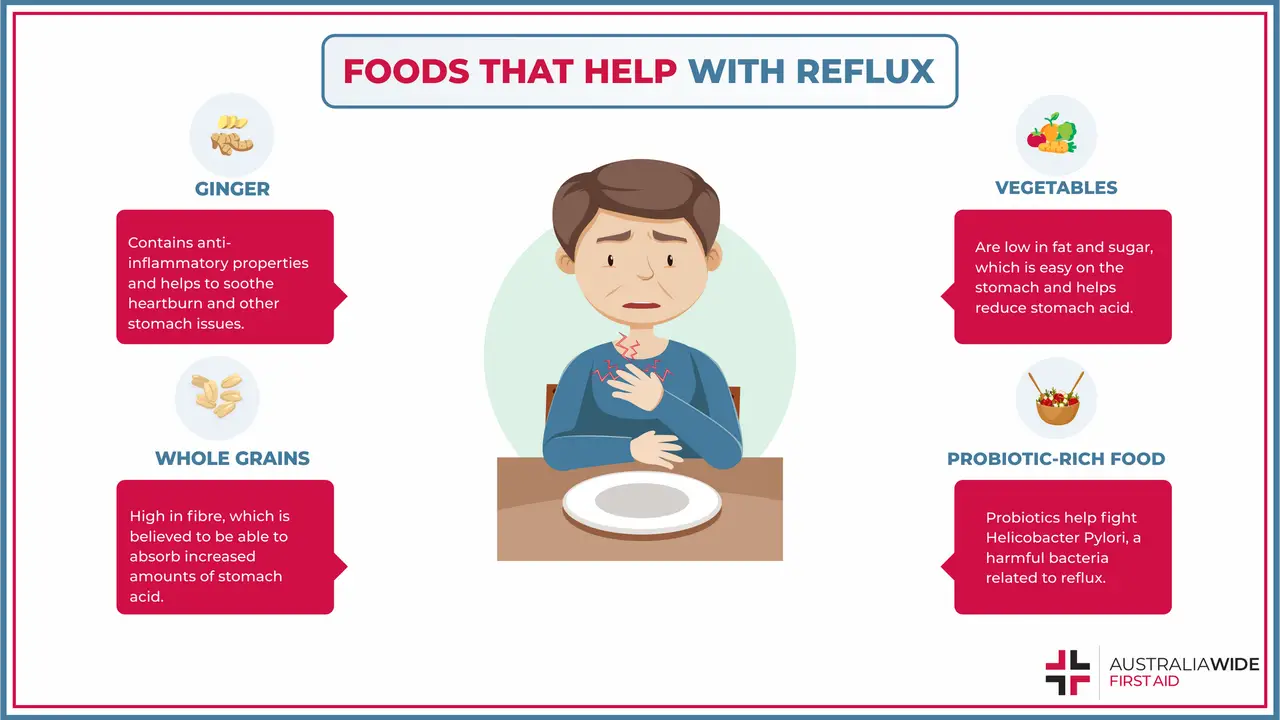Foods That Help with Acid Reflux


Acid reflux, also known as heartburn, is used to describe the feeling of pain in the chest resulting from stomach acid moving back into the oesophagus.
This occurs when the part of the oesophagus that allows food to enter the stomach, the lower oesophageal sphincter, has problems tightening properly, allowing the backflow of stomach acid into the oesophagus. While there are often little to no major health risks associated with reflux, if the symptoms are too great and is beginning to hinder your day-to-day activities, you may need to consult a doctor.
Reflux, while generally harmless, can cause intense feelings of pain. The general rule of thumb is to wait for the discomfort to pass but there are also different foods that can soothe the pain. Follow this guide to learn which foods can help stimulate relief from acid reflux discomfort and which ones to avoid.
While there is no definite cure for reflux and symptoms usually go away with time. There are some foods that can help alleviate some of the discomfort brought on by reflux.
Probiotics are beneficial, live bacteria found in certain foods that help maintain and restore balance in your system by fighting bad bacteria in your body. Doctors believe that an increase in Helicobacter Pylori, a type of harmful bacteria, in the body is related to reflux. Probiotics can help fight off Helicobacter Pylori.
Probiotic rich food that can help reduce reflux include:
Ginger is good for treating reflux because it has anti-inflammatory properties. It can be used to soothe heartburn and other stomach issues. In addition to dealing with stomach and chest pain, it also relieves nausea which can often be a side effect of reflux.
Because it can be difficult to eat raw ginger, you can consider adding it to your recipes or drink. You can also make ginger tea as well.
Vegetables are good for reflux because they do not contain anything that can trigger reflux symptoms, like fat, spice, or acidity. Veggies being low in fat and sugar also helps reduce stomach acid as well as be easy on the stomach.
Remember how you prepare your food is also something that can affect reflux. Frying your greens would not be a good idea because it uses a lot of oil, which intensifies reflux symptoms.
Some vegetables that can help reduce reflux include:
Food that is high in fibre is believed to help lower acid reflux symptoms. Whole grains are high in fibre and is believed to be able to absorb the increased amount of stomach acid, reducing reflux symptoms.
Some whole grain food that can help reduce reflux include:
Fruits are a good combatant to reflux. Being low in fat and high in fibre protects against many reflux symptoms. However, not all fruits are good to eat when you have reflux. Citrus fruits can exacerbate symptoms of reflux because it is acidic. Food with high acidity add to the high levels of acid that is already in the stomach.
Some non-citrus fruits that can help reduce reflux include:
Low fat meats and protein can reduce discomfort caused by acid reflux. Make sure when choosing what to eat, you are mindful of the fat content as it can increase reflux. How you prepare the protein can also affect your reflux.
Cooking methods that require a lot of oil like frying, intensifies reflux.
Some low-fat protein that can help reduce reflux include:
When you are experiencing symptoms of acid reflux, there are foods that you should avoid to prevent discomfort from increasing. Keep in mind that everyone’s body is different. Different foods have different effects on different people.
Some categories of food may increase reflux symptoms while other foods may result in no changes to your symptoms.
Food that have high acidity levels can worsen reflux symptoms. This is because acidity relaxes the esophageal sphincter, which causes stomach acid to flow back into the esophagus. Furthermore, adding more acidity into your system when you already have high levels of stomach acid worsens the symptoms.
Acidic food that can increase symptoms of reflux include:
Greasy, oily, and fatty foods are bad for reflux because it causes the lower oesophageal sphincter to relax. This allows for stomach acid to rise back into the oesophagus easily. In addition to this, fatty foods are hard to digest and delays the stomach from emptying.
Fatty and greasy food that can increase symptoms of reflux include:
Capsaicin is found only in spicy food, which is a main trigger for reflux symptoms. Furthermore, it can act as an irritant to your lower esophageal sphincter and esophagus which make reflux symptoms even more uncomfortable.
Spicy food that can increase symptoms of reflux include:
We run certified First Aid courses throughout all major Australia citys. Find a location near you.
There are other foods that can increase the symptoms of reflux. These include:
For more information on how to manage symptoms of acid reflux, check out the video below:
We also have a first aid chart on acid reflux that can be downloaded and printed in A2 size or smaller.
Acid reflux is a condition in which stomach acid rises into the oesophagus.
It occurs when the oesophageal sphincter does not tighten properly and allows acid to flow from the stomach back into oesophagus.
This can cause a burning sensation in the chest, known as heartburn, and lead to oesophageal scarring and damage if left untreated.
There are certain foods that you can eat at home to lessen the symptoms of heartburn, including probiotic-rich foods, ginger, and vegetables (among many others).
To learn more about how to identify and manage the symptoms of acid reflux, book a First Aid course with Australia Wide First Aid today.

March 25, 2025
Explore non-traditional paths to sobriety, including mindfulness, yoga, nutritional therapy, and community-based support, for a personalized approach to recovery.

September 7, 2022
Menopause is the final period, when a woman, trans man, or non-binary person assigned female at birth's ovaries run out of eggs and the body can no longer ovulate. Menopause comes with several symptoms, complications, and treatment options.

July 26, 2024
Transcutaneous Electrical Nerve Stimulation (TENS) is a therapeutic method of pain relief. It utilises an electrical device that emits electrical currents and streams the impulses via electrode patches attached to the skin.